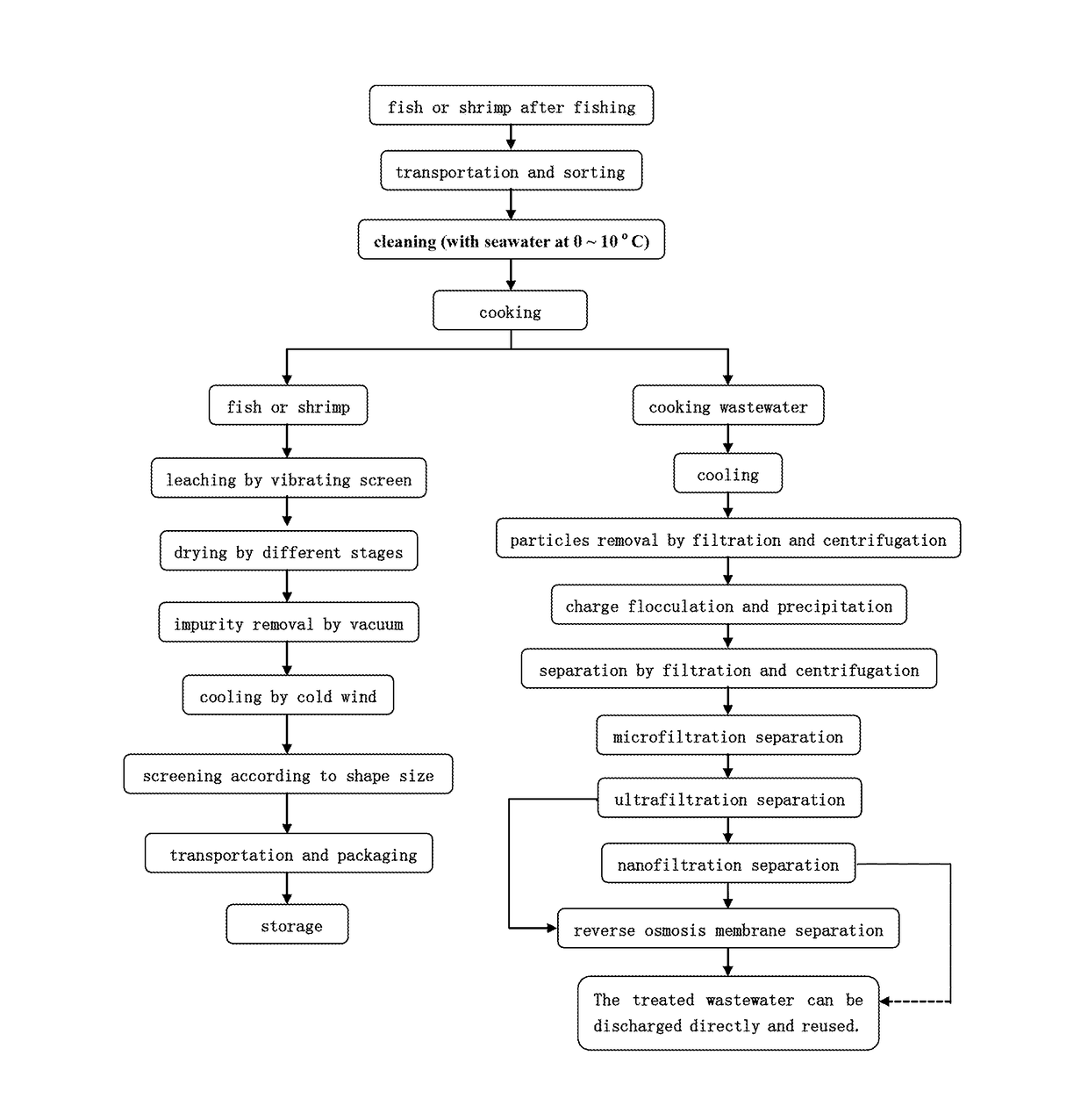Continuous on-board processing of seafood after fishing on the sea
a technology of seafood and processing equipment, applied in the field of continuous on-board processing of seafood after fishing on the sea, can solve the problems of low-fresh raw materials, easy deterioration, low processing efficiency, etc., and achieve the effects of reducing quality and safety, low processing cost, and preserving raw materials
- Summary
- Abstract
- Description
- Claims
- Application Information
AI Technical Summary
Benefits of technology
Problems solved by technology
Method used
Image
Examples
example 1
[0047]Referring to FIG. 1, a continuous on-board processing of fish or shrimp after fishing on the sea is executed as follows:
[0048]1) Cleaning and sorting of fishing shrimp: The fresh and live shrimp is cleaned by seawater, sorted. The temperature of seawater is controlled between 0° C. to 10° C.
[0049]2) Cooking: 2000 L of cooking soup containing a quality improver are put into a cooking tank. The cooking soup containing the quality improver is composed of edible alcohol (2 kg, produced by Jiangsu Donghai Shuntai Alcohol Co. Ltd.), glucono-delta-lactone (1 kg), tea polyphenol (4 kg), perilla juice (2 kg, produced by Zhejiang Shizi Bio-tech Co. Ltd.), hexametaphosphate (5 kg), and water. The cooking soup in the tank is heated until the temperature is up to 90° C. The shrimp is added into the tank to cook for 6 min, with the purpose of inactivation of enzyme (mainly endogenous proteases), reduction of microorganism, and meat dewatering. The solid-liquid ratio is controlled at 1:10. T...
example 2
[0057]1) 200 kg of clove fish are cleaned by seawater, and sorted. The temperature of seawater is controlled between 0° C. and 10° C.
[0058]2) 1000 L of cooking soup containing a quality improver are put into cooking tank. The cooking soup containing the quality improver is composed of salt (60 kg), edible alcohol (2 kg, produced by Jiangsu Donghai Shuntai Alcohol Co. Ltd.), glucono-delta-lactone (4.5 kg), tea polyphenol (200 g), perilla juice (1 kg, produced by Zhejiang Shizi Bio-tech Co. Ltd.), hexametaphosphate (500 g) and water. The cooking soup in the tank is heated until the temperature is up to 100° C. The clove fish (200 kg) is added into the tank to cook for 2 min. The cooking soup is replaced with new one every 2 hours. The replaced cooking soup (i.e., heat processing wastewater) should be treated to become more suitable for environment.
[0059]3) After leached on a stainless steel net, the cooked clove fish is put onto a vibrating screen with vibrating frequency of 750 r / min...
example 3
[0066]1) 250 kg of acete chinensis with 2 cm length are cleaned by seawater, and sorted. The temperature of seawater is controlled within 0˜10° C.
[0067]2) the acete chinensis is brought into cooking tank with a bucket elevator. 2000 L of cooking soup containing a quality improver is put into cooking tank. The cooking soup containing the quality improver is composed of salt (50 kg), edible alcohol (6 kg, produced by Jiangsu Donghai Shuntai Alcohol Co. Ltd.), glucono-delta-lactone (5 kg), tea polyphenol (2 kg), perilla juice (1 kg, produced by Zhejiang Shizi Bio-tech Co. Ltd.), hexametaphosphate (5 kg), and water. The cooking soup in the tank is heated to 98° C. and maintained for 4 min. The cooking soup is replaced with new one every 2 hours. The replaced cooking soup (i.e., heat processing wastewater) should be treated to become more suitable for environment.
[0068]3) After leached on a stainless steel net, the cooked acete chinensis is put onto a vibrating screen with vibrating freq...
PUM
| Property | Measurement | Unit |
|---|---|---|
| temperature | aaaaa | aaaaa |
| velocity | aaaaa | aaaaa |
| velocity | aaaaa | aaaaa |
Abstract
Description
Claims
Application Information
 Login to View More
Login to View More - R&D
- Intellectual Property
- Life Sciences
- Materials
- Tech Scout
- Unparalleled Data Quality
- Higher Quality Content
- 60% Fewer Hallucinations
Browse by: Latest US Patents, China's latest patents, Technical Efficacy Thesaurus, Application Domain, Technology Topic, Popular Technical Reports.
© 2025 PatSnap. All rights reserved.Legal|Privacy policy|Modern Slavery Act Transparency Statement|Sitemap|About US| Contact US: help@patsnap.com

